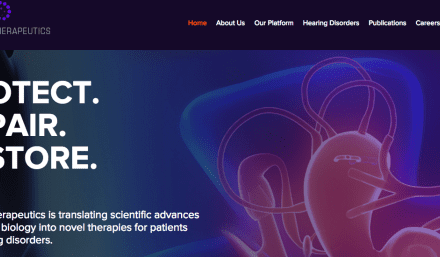Sounding the call to meet the increasingly diverse needs of the hearing health care market.

The hearing instrument market is constantly evolving and shifting—in terms of those who are hard of hearing and the products that are designed to improve their journey to better health.
Looking at the patient pool, we need to consistently remember that hearing loss is not age discriminate—while we will likely see an increased market size in older patients due to the first Baby Boomers turning 60 at the start of this year, we may also see an increased market size in tweens, teens, and Gen Xers due to the younger generation spending more and more time listening to music with iPod and MP3 earbuds.
It is imperative, then, that as manufacturers, we strive to meet the needs of this increasingly diverse patient base with products that address their vast and varying needs. At Starkey Laboratories, that means spending a significant amount of dollars on research and on developing and/or advancing technologies that will improve the journey for patients of all ages.
The Patient Journey
Defining a patient experience as a journey is perhaps one of the most respectful and meaningful ways to approach hearing loss. Whether practitioners want to believe it or not, patients do not just lose their hearing, purchase a hearing aid, and live happily ever after. Rather, they process their hearing loss and come to terms with it. Then they agree to have their hearing tested and to try a hearing aid. Then they gradually learn to use the hearing aid. Perhaps most important, they accept that the hearing aid will not return them to normal hearing but rather will help them achieve improved hearing and, as a result, improved interactions with loved ones.
Subscribing to the belief that each patient is on a journey to better hearing allows practitioners to create long-term relationships with their patients; it empowers practitioners to improve the quality of life for their patients.
The Hearing Industries Association, Alexandria, Va, recently initiated a consumer focus class designed to better understand the patient journey.1 The focus group aimed to uncover why those suffering from hearing loss either did not pursue treatment or, if they did, did not use the resulting hearing device on a regular basis.
Sadly, when a group of class participants who were identified as having a potential hearing loss but who had failed to get tested or evaluated was asked what they planned to do about their hearing loss, all stated that they planned to do nothing. Why? Some mentioned the hearing loss to their physicians, but received nonspecific direction on what to do. Several said their physicians informed them that there were no good hearing options available. Many said they heard from friends that hearing devices do not work. And many also said they felt there were no good solutions for hearing loss.
A second group of participants had their hearing tested and were fitted with hearing instruments, but they had not actually purchased them. The reasons for not moving forward with the purchase included patient doubt of the validity of the recommendation, the feeling that the test results did not match the patient’s self-perception of their hearing problem, or the inability to try a hearing device prior to purchasing it.
A third group of participants owned and used their hearing devices. Those who were most satisfied suggested that they had been provided extensive training and counseling on how the device would work, how it would impact their ability to hear, and how to use it on an ongoing basis. Those who were least satisfied suggested they had been given minimal training.
The focus group results clearly suggest that patients are on a journey—from the point of admitting to themselves that they have a hearing loss through to reaping the rewards of using a hearing device to its fullest potential. The results also suggest that manufacturers must strive to produce hearing instruments that are easy to use and that resolve some of the long-standing problems hearing aid wearers have. And they suggest that practitioners must take the time to help their patients understand the value that hearing devices offer and provide them with sufficient training so the patients attain that value.
Product Innovation
Turning to products, here in the United States, the hearing industry has effectively converted analog hearing devices to digital technology. In doing so, manufacturers are now able to produce hearing devices that are smaller, more powerful, and, in many cases, less problematic for the patient. As is the case in most industries, the conversion from analog to digital technology has not offered manufacturers the opportunity to sit back and rest, but rather it has presented them with the challenge to take hearing devices to the next level. Now, devices are being designed that incorporate wireless technology and that are smart or intuitive.
Whether digital or smart, the hearing devices of today—and tomorrow—do not incorporate new emerging technologies for technology’s sake, but rather for the sake of the patient and an improved patient journey.
For example, industry research indicates that hearing instrument wearers report excellent results with their hearing devices in normal listening situations, but poorer results when they use the phone, which can create acoustic feedback, static, and poor hearing instrument signal strength. To resolve the problems, Starkey turned to existing consumer technology and applied it to the hard-of-hearing market.

The result? ELI (Ear Level Instrument), the first device that turns hearing aids into wireless headsets. ELI uses Bluetooth® technology to send an audio signal between a digital mobile phone and a wearable module attached to the direct audio input boot of a BTE hearing instrument. When used with Bluetooth-enabled phones, ELI automatically overrides the hearing instrument’s microphone signal, essentially turning the instrument into a wireless cell phone headset. This dramatically improves the instrument’s sound quality and clarity while eliminating acoustic feedback and static problems.
One of the interesting features of the ELI design is that it uses the wearer’s personal hearing device to process the audio signal. As a result, all frequency shaping, gain, and compression characteristics, which are already established for acoustic inputs, are now applied to the signal from the mobile phone.
While ELI marks a significant step forward in the development of wireless technologies for people with hearing loss, it is also only a first step. Starkey plans to release two additional Bluetooth products in 2006, as well as additional wireless devices and processing schemes to follow in the next 3 to 5 years.
Another frequent problem for hearing device wearers is the device’s inability to adjust to various listener environments. To address that, Starkey has introduced sophisticated hearing instruments—devices that, for example, automatically adjust to the wearer’s environment. If the thermostat can be programmed to automatically increase or decrease the temperature inside the home based on the temperature outside the home, surely a hearing device should be able to automatically classify and react to sounds, shift its microphone directionality, or move into “telephone” mode.
And what hearing professional hasn’t struggled with the ability—or lack thereof—to provide real-world testing of the hearing device before the patient leaves their fitting? Starkey is moving forward with a new approach to the fitting process that incorporates intuitive software that allows for real-world feature demonstrations. It also includes data-logging capabilities so that the practitioner can analyze exactly how the hearing aid is reacting in various patient situations.
Certainly, every hearing professional has had the experience of fitting hearing aids to a person with a mild-to-moderate hearing loss, only to have the instruments returned 2 weeks later. Reasons for rejection might include unnatural sound quality, discomfort, feedback, circuit noise, the hollow sound of the wearer’s own voice, or simply the lack of significant benefit. These and other less specific and often unstated issues have led to rejection of hearing aids by people who may have received considerable benefit from them.
By updating an old, open-ear approach with new digital signal processing techniques and ongoing miniaturization, current open-ear devices have great potential to penetrate the mild-loss market—perhaps, most importantly, the Boomer market. Success in this large market segment assures practice growth for hearing professionals and offers the benefits of amplification to a population that has been uncertain about proceeding with hearing care. Furthermore, these benefits are being achieved with devices that are smaller, less intrusive, more comfortable, and more effective than their predecessors.
Blurring The Lines
The technologies applied to the hearing industry have advanced dramatically in the recent past. But still, as noted earlier, there is a resistance among many of those who need hearing devices to actually wearing those devices.
Because a growing number of normal-hearing people are seen wearing gadgets in their ears to help them keep in touch with the world by phone, one solution is to introduce devices that blur the lines between those who are hard of hearing and those who are not; in other words, converging hearing aid technology and consumer communications technology.


For example, Starkey is in the process of rolling out its first product for the non-hearing impaired market. SoundPort™ is the world’s first custom-fit Bluetooth EarSet for non-hearing impaired users of Bluetooth-compatible mobile phones.
Unlike traditional wireless headsets, the SoundPort EarSet features a custom-fit earpiece that is professionally molded and acoustically tuned to fit the exact contour of the wearer’s outer ear. The earpiece, which is fully vented so that nearby sounds and conversations can be heard normally, anchors SoundPort’s sleek, digital electronics to deliver the ultimate in comfort, freedom, and safety to enable users to work and drive while using a mobile phone.

By making wireless in-the-ear devices, such as SoundPort, for those with normal hearing, Starkey hopes to make it “cool” to wear a device in or on your ear and, therefore, make it more socially acceptable to wear a hearing instrument. This is key to growing the hearing market, particularly among that younger potential patient base.
The gadgets currently used by the non-hearing impaired have multifunctional possibilities; their application could easily expand from pocket audio players and mobile phones to conversational assistance in a noisy meeting place or worksite. As these more expansive wireless possibilities develop, wireless products might mark the beginning of a convergence of the hearing impaired market with the normal hearing market, and today’s hearing aid office may give way to an ear store concept, serving the hearing assistive needs of an entire population.
What’s Next?
As technology advances, it seems the possibilities are endless as it relates to developing devices that improve the patient journey. The future of the hearing health care industry should focus on devices for the ear that are tailored to the needs of each and every individual—whether hard of hearing or not.
Jerry Ruzicka is president of Starkey Laboratories, Eden Prairie, Minn, and was chairman of the Hearing Industries Association from 2002 through 2004.
Reference
1. Hearing on the Hill: Consumer Focus Groups. Alexandria, Va: Hearing Industries Association; May 2005.



